![]()
![]()
![]()
Use LEFT and RIGHT arrow keys to navigate between flashcards;
Use UP and DOWN arrow keys to flip the card;
H to show hint;
A reads text to speech;
34 Cards in this Set
- Front
- Back
- 3rd side (hint)
|
-Describe features of Cystic Fibrosis as an autosomal recessive genetic disorder causing a chronic obstructive pulmonary disease involving a defective Chloride channel protein
|
.
|
|
|
|
-Describe emphysema and pneumonia
|
.
|
|
|
|
-Describe Chronic smoking as an inducer of the transformation of respiratory epithelium into a stratified squamous epithelium, an initial step in its eventual transformation into a tumor
|
.
|
|
|
|
-Describe the use of Epinephrine and other sympathomimetic drugs to relax smooth muscle during asthma attacks
|
.
|
|
|
|
Divisions of Respiratory Tract
|
Anatomically:
Functionally: |
Anatomically:
the Upper Respiratory Tract (U R T) the Lower Respiratory Tract (L R T) Functionally: Conducting passages Transitional zone Sites of Gaseous exchange |
|
|
Anatomically:
<Divisions of Respiratory Tract |
the Upper Respiratory Tract (U R T)
the Lower Respiratory Tract (L R T) |
|
|
|
Functionally
<Divisions of Respiratory Tract |
Conducting passages
Transitional zone Sites of Gaseous exchange |
|
|
|
Functions of the Respiratory System
|
-Conditioning of air (filteration, temperature adjustment and humidification).
-Olfaction Phonation (production of sound) -Gas exchange -Metabolism- air and blood-borne compounds -Defense-immune system |
|
|
|
The basic structural feature of the functional epithelium is the =
Sites of Gaseous Exchange: |
extraordinary reduction of the tissue mass to extremely thin and extensive sheets so that the functional components, air and blood are its major constituents and are brought into very intimate and extensive contact.
|
|
|
|
Typical Respiratory Epithelium
LM: |
Pseudostratified columnar ciliated with Goblet cells
(Typical Respiratory Epithelium). |
|
|
|
Three types of cells are identifiable
Typical Respiratory Epithelium |
Columnar ciliated
Goblet cells Basal cells |
|
|
|
EM: 6 cell types
Typical Respiratory Epithelium |
Ciliated columnar cells
Mucous goblet cells Brush Cells other Brush cells Basal cells Small granule cells |
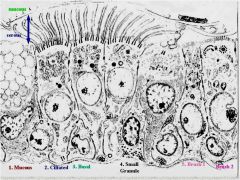
| | | | | |
Mucous Ciliated Basal Small Brush other Brush |
|
|
Ciliated columnar cells:
Typical Respiratory Epithelium |
Most abundant
~ 300 cilia per cell Mitochondria below apical surface |
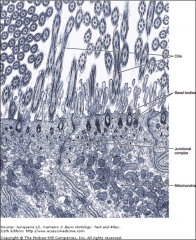
|
|
|
Goblet cells:
Typical Respiratory Epithelium |
Secretion of mucous
Complement of the mucous glands Dissolve several substances (O3, SO2) Proliferate with chronic exposure to irritants. |
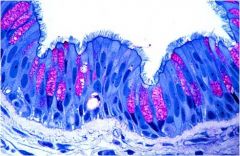
|
|
|
Most abundant
~ 300 cilia per cell Mitochondria below apical surface what cells = |
Ciliated columnar cells:
|
|
|
|
Brush cells have numerous microvilli on their apical surface. Brush cells have _______ nerve endings on their basal surfaces and are considered to be sensory receptors.
|
afferent
no Q about brush cells |
|
|
|
Small granule cells
|
diffuse neuroendocrine system
pic |
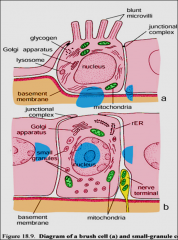
|
|
|
main function of the typical respiratory epithelium is =
Typical Respiratory Epithelium |
mucus layer by ciliary action (Mucociliary escalator).
|
|
|
|
***
Kartagener’s syndrome aka = |
Immotile cilia syndrome
deficiency of dynein causes what = 2ct |
causes infertility in men
chronic respiratory tract infections in both sexes |
|
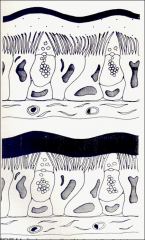
Mucociliary Escalator
|
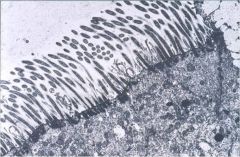
Sol layer (Periciliary fluid)
|
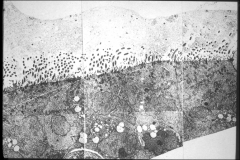
Mucous (gel) phase (superficial)
|
|
|
Changes in the character of Respiratory Epithelium =
5ct |
-Pseudostratified columnar ciliated
to -Simple columnar ciliated to -Simple cuboidal ciliated to -Simple cuboidal nonciliated to -Simple squamous |
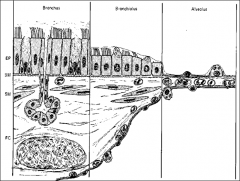
|
|
|
In the regions exposed to direct air flow or physical abrasion (wear & tear) the respiratory epithelium changes to
|
stratified squamous non-keratinizing type e.g.
3ct |
pharynx,
epiglottis vocal cords. |
|
|
In smokers, the proportion of ciliated cells to =
|
goblet cells is altered.
|
Clinical Note:
If air currents are changed, the affected area changes from typical respiratory epithelium to stratified squamous. In smokers, the proportion of ciliated cells to goblet cells is altered. |
|
|
Nasal Cavities are divided into:
Upper Respiratory Tract |
1 Vestibule
2 Nasal fossae Respiratory segment Olfactory segment |
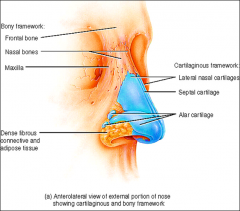
|
|
|
Vestibule:
Anterior & dilated portion of the nasal cavity Within nares epithelium changes into = Upper Respiratory Tract |
non-keratinizing stratified squamous.
|
|
|
|
Vestibule:
Anterior & dilated portion of the nasal cavity Outer skin = Upper Respiratory Tract |
stratified squamous keratinizing
|
|
|
|
Around nares (nostrils) are numerous
_______ & ____________ glands |
sebaceous
sweat glands also have thick short hairs called = |
vibrissae
|
|
|
Nasal Fossae:
Upper Respiratory Tract |
Outside nares =
Within nares epithelium = Nasal Fossae:= |
Outer skin stratified squamous keratinizing
non-keratinizing stratified squamous. changes to pseudostratified columnar ciliated epithelium with goblet cells Epithelium lies upon a basal lamina and is supported by connective tissue layer, lamina propria contains tubuloalveolar glands Lamina propria contains small collections of lymphatic tissue. Lamina propria lies on the periosteum or perichondrium thus forming mucoperiosteum or mucoperichondrium |
|
|
Nasal cavity is divided by a septum.
Extending from the lateral walls are 3 bony shelf like projections known as = |
chonchae
covered by = |
mucoperiosteum
|
|
|
Nasal Cavity:
mucoperiosteum describe = |
Superior-
Middle- Inferior- |
Superior- covered by olfactory & Resp. epithelium
Middle- covered by Resp. epi Inferior- covered by Resp. epi |
|
|
*Swell Bodies =
|
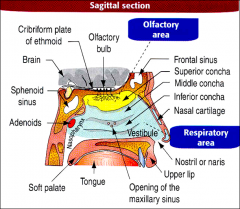
superficial plexus of large thin walled vessels called =
|
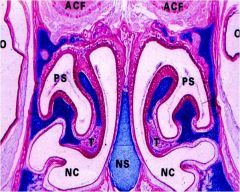
cavernous
or erectile tissue, common site of nose bleed. |
|
|
Inferior concha
|
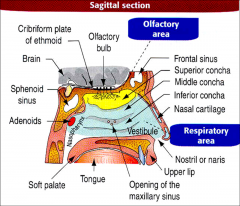
Mucoperiosteum
Epithelium Lamina propria Bone |
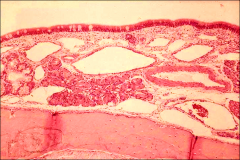
|
|
|
Olfactory Epithelium
Specialized area of nasal epithelium on dorsal surface of nasal passage Type of Epithelium |
Pseudostratified columnar
ciliated epithelium w 3 cell types = ______ cells are not found here = ______bodies are not present = |
Olfactory receptor neurons with axons projecting to olfactory bulb
Supporting cells Basal cells goblet cells Swell bodies are not present. |
|
|
Olfactory Epithelium
_____ _____ layer contain |
Lamina propria
what glands |
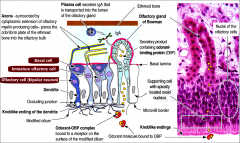
serous glands aka=
Bowman’s glands |

